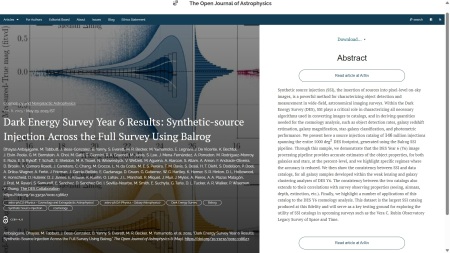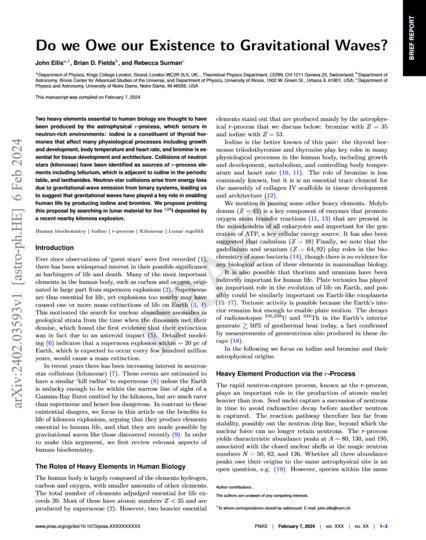@hausderastronomie
#physik #asto #astrophysics #astrophysik #physics #rprocess
#heidelberg #hausderastronomie
#rProcess
Weekly Update from the Open Journal of Astrophysics – 31/05/2025
Once again it’s time for the weekly Saturday morning update of papers published at the Open Journal of Astrophysics. Since the last update we have published five new papers, which brings the number in Volume 8 (2025) up to 67; the total so far published by OJAp has passed the 300 mark and is now up to 302. If we keep up at the same rate for the rest of the year as we did for the first five months now completed, we will publish around 160 papers altogether in 2025.
In chronological order of publication, the five papers published this week, with their overlays, are as follows. You can click on the images of the overlays to make them larger should you wish to do so.
The first paper to report is “Which is the most eccentric binary known? Insights from the 2023/4 pericenter passages of Zeta Boötis and Eta Ophiuchi” by Idel Waisberg, Ygal Klein and Boaz Katz (Weizmann Institute of Science, Israel). This is a report of interferometric observations of two very eccentric binary star systems, published on Tuesday 27th May 2025 in the folder Solar and Stellar Astrophysics. The overlay is here:
You can read the final accepted version on arXiv here.
The second paper to report is “On the full non-Gaussian Surprise statistic and the cosmological concordance between DESI, SDSS and Pantheon+” by Pedro Riba Mello & Miguel Quartin (Universidade Federal do Rio de Janeiro, Brazil), and Bjoern Malte Schaefer & Benedikt Schosser (Heidelberg, Germany). This paper is in the folder Cosmology and NonGalactic Astrophysics and was published on Tuesday 27th May 2025. The paper presents an application of the “Surprise Statistic”, based on the Kullback-Leibler divergence, as a measure of the difference between results inferred from different data sets.
The overlay is here:
You can find the officially-accepted version of the paper on arXiv here.
The third paper we published last week, and our 300th overall, is “Cosmic Ray Feedback in Massive Halos: Implications for the Distribution of Baryons” by Eliot Quataert (Princeton, USA) and Philip F. Hopkins (Caltech, USA). This was published on Thursday 29th May in the folder Cosmology and NonGalactic Astrophysics. The paper discusses the effects of cosmic rays produced by massive black holes on the structure of the baryonic component of galaxies and how these might affect cosmological parameter estimation. The overlay is here:
You can read the officially accepted version of this paper on arXiv here.
The next one to report is “Mixing neutron star material into the jets in the common envelope jets supernova r-process scenario” by Noam Soker (Technion, Israel). This was published on Thursday 27th May in the folder High-Energy Astrophysical Phenomena; it presents a discussion of the chemical enrichment of an evolved star consequent upon its ingestion of a neutron star.
The overlay is here:
You can find the officially accepted version on arXiv here.
Last, but by no means least, for this week we have “Dark Energy Survey Year 6 Results: Synthetic-source Injection Across the Full Survey Using Balrog” by Dhayaa Anbajagane (Kavli Institute, Chicago) et al. (81 authors) on behalf of the Dark Energy Survey Collaboration. It was also published on Thursday 27th May 2025, but in the folder Cosmology and NonGalactic Astrophysics. It is about testing the Dark Energy Survey analysis pipeline using synthetic sources.
The overlay is here:
You can find the officially accepted version on arXiv here.
That’s all the papers for this week. I’ll post another update next weekend.
#arXiv240808385v2 #arXiv250105683v3 #arXiv250201753v2 #arXiv250202411v2 #arXiv250417858v2 #binaryStars #CosmologyAndNonGalacticAstrophysics #DarkEnergySurvey #DiamondOpenAccess #DiamondOpenAccessPublishing #HighEnergyAstrophysicalPhenomena #neutronStar #OpenJournalOfAstrophysics #rProcess #SolarAndStellarAstrophysics #TheOpenJournalOfAstrophysics
in the #arXiv
Do we Owe our Existence to Gravitational Waves?
by John Ellis and co-authors
https://arxiv.org/abs/2402.03593
#GravitationalWaves #humanbiology #humanbiochemistry #human #biology #biochemistry #chemistry #iodine #rprocess #neutron #capture #neutroncapture #nuclear #physics #nuclearphysics #kilonovae #lunar #regolith #lunarregolith #neutron #stars #neutronstars #binary #systems #bromine #heavyelements #life #astronomy #astrophysics #astrodon #space #science #research #LIGO #VIRGO
Oude sterren konden elementen met atoommassa groter dan 260 maken
Het rapid neutron capture process, oftewel het r-process, vindt plaats in neutronenrijke omgevingen zoals fusies van neutronensterren of bepaalde soorten supernova’s. Aangenomen wordt dat dit proces veel van de chemische elementen produceert di
https://www.kuuke.nl/oude-sterren-konden-elementen-met-atoommassa-groter-dan-260-maken/
#edelmetalen #elementen #kernsplijting #neutronensterren #rprocess #ZeldzameAardmetalen
#Kilonova: When #NeutronStars Collide
"#Kilonovas get their names from the fact that they are 1000 times brighter than a #Nova. This does mean that they are about 1 tenth to 1 hundredth the #Brightness of a #Supernova, and because of how they form they are incredibly interesting indeed."
https://www.youtube.com/watch?v=7wKFxSwI_84&ab_channel=LearningCurve
#Astronomy #Astrophysics #Gravity #GravitationalEnergy #LIGO #Interometry #WarpedSpaceTime #SpaceTime #Warping #Elements #RProcess

